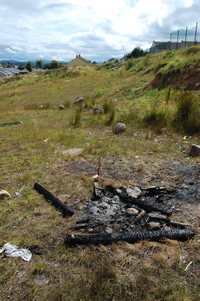 A view from the mound at Navan Fort.
A view from the mound at Navan Fort.There was a time when Northern Ireland was ruled by God kings. Chieftains led clans who fought in fearsome battles, rituals were practiced daily in hopes of pleasing the Gods, and mighty stones marked sacred places in the land.
A blurring of Christianity and Druid custom spans back thousands of years. Walking through this city you will see tributes to the warrior hero Cu Chulainn. Look towards any church and you will see the Celtic cross. In this land that has managed to maintain so much of its natural beauty, its pagan ancestry remains obvious to anyone who wishes to see it.
Hundreds of tales of the power and bravery of the almost supernatural hero, Cu Chulainn flow freely from person to person. Truly a legendary figure, Cu Chulainn remains a prominent symbol throughout the city inspiring both the Loyalist and Unionist parties, according to former I.R.A. member John Nixon who now works at Solstice Art Gallery in Armagh.
Cu Chulainn’s feats in the Cattle Raid of Cooley have made him a permanent fixture in the city of Armagh many locals say point out the murals dedicated to his physical form as well as pubs that bear his namesake throughout the city. Most historians agree the Celtic hero has been leaving his mark almost from the start.
St. Brigid continues to be of great importance to both the Old Religion as well as Christianity in Celtic culture, according to Ann Hart, who is married to Druid Rhymer and used to teach at the Amma Center. There is the belief of some that when the Christian church came to Ireland they deemed Brigid a saint to convince Druids to convert.
Her day of celebration is February 1st or the pagan holiday of Imbolc. Imbolc is one of four main holidays on the Celtic calendar. It represents the start of the new spring season and the preparation for the sowing of new crops for winter.
Signs of pagan life go beyond legendary figures and sacred locations. Perhaps the most common symbol in Ireland is the Celtic cross. Although used most abundantly as a sign for the church, the Celtic cross’s true origins have roots in Celtic and pagan folklore.
The Celtic cross may have originally been an adaptation of the symbol of the sun god Lugh, says Gabriel Mallon of the Navan Center. In Ireland, it is a popular myth that St. Patrick introduced the Celtic cross to the island during his time converting the pagans around 432 A.D.
It is believed that he combined the symbol of Christianity, a cross, with the symbol of the sun, to give pagan followers an idea of the importance of the cross by aligning it with the idea of the life-giving properties of the sun.
In Wicca, the Celtic cross is used to represent the Sun and Moon, God and Goddess, or Male and Female. Also, it bears a very similar resemblance to what is known as a spirit circle, where in the four points of the cross represent the four directions and the circle encloses them all to create the cone of power. Not just a Wicca tool, a spirit circle can be used at a birthing, or during a wedding ceremony to bring good luck and ward of evil spirits.
Perhaps Armagh’s best example of holding on to its older way of life would be the well-tended beauty of Emain Macha or the Navan Fort. Although Fort is in its title, Emain Macha is actually believed to be a ceremonial site.
Two ancient monuments identify the chosen land of Macha, the sacred mound at the top of the hill and the ritualistic ring that encircles the mound. This ring is the famed circle that the Goddess Macha may have ridden in the epic chariot race where she lost her life after going to into childbirth there on the mound. As she lay dying she cursed the men of Ulster to suffer her same pains every time a crucial moment in their lives occurred.
Traveling to this sacred site one can still see the remnants of pagan worshipers in the ashes of the fire rings and the gifts left for the Gods. Ribbons are still tied to trees in honor of saints long gone and food is often left on doorsteps to feed wandering spirits. Pagan culture is still alive and well in Armagh, just look about to see it for yourself.

